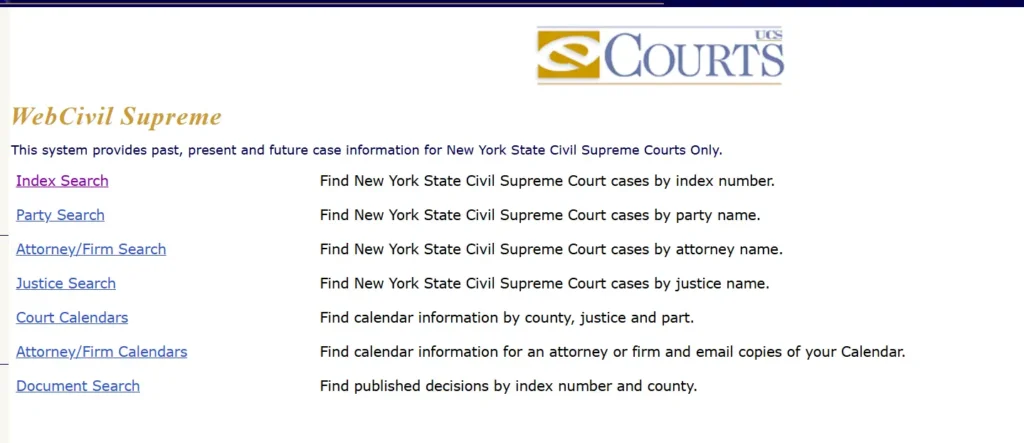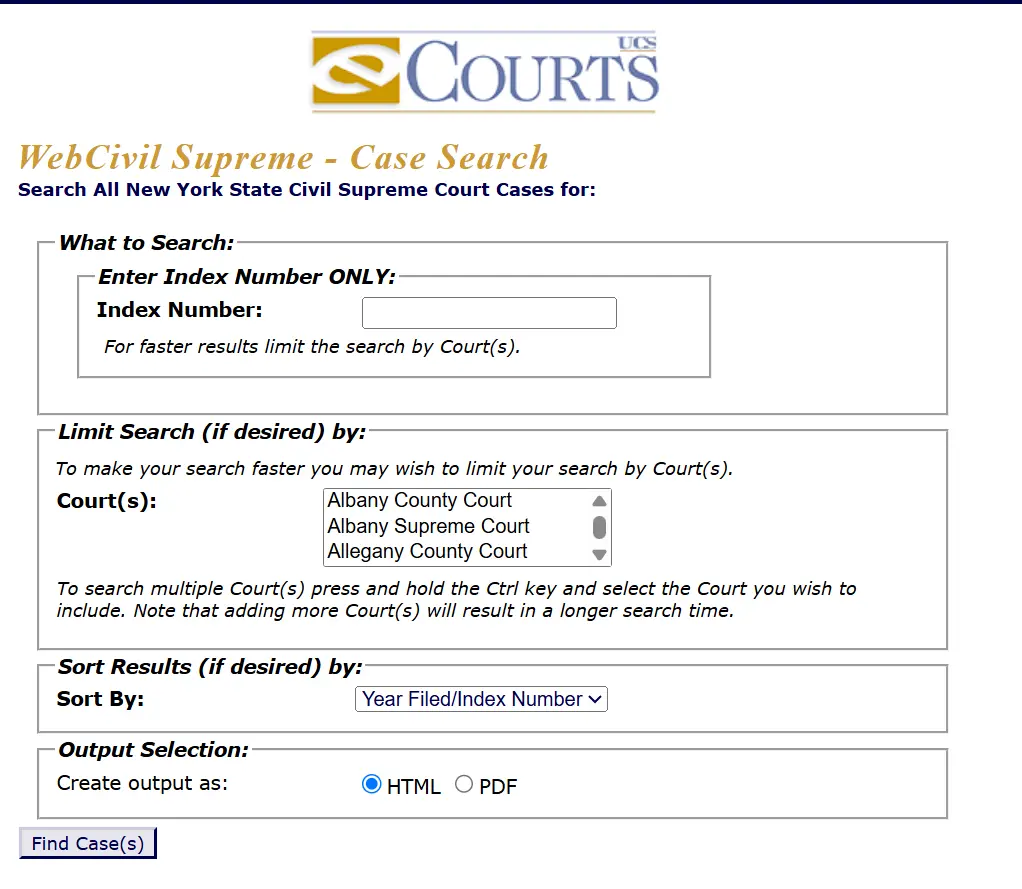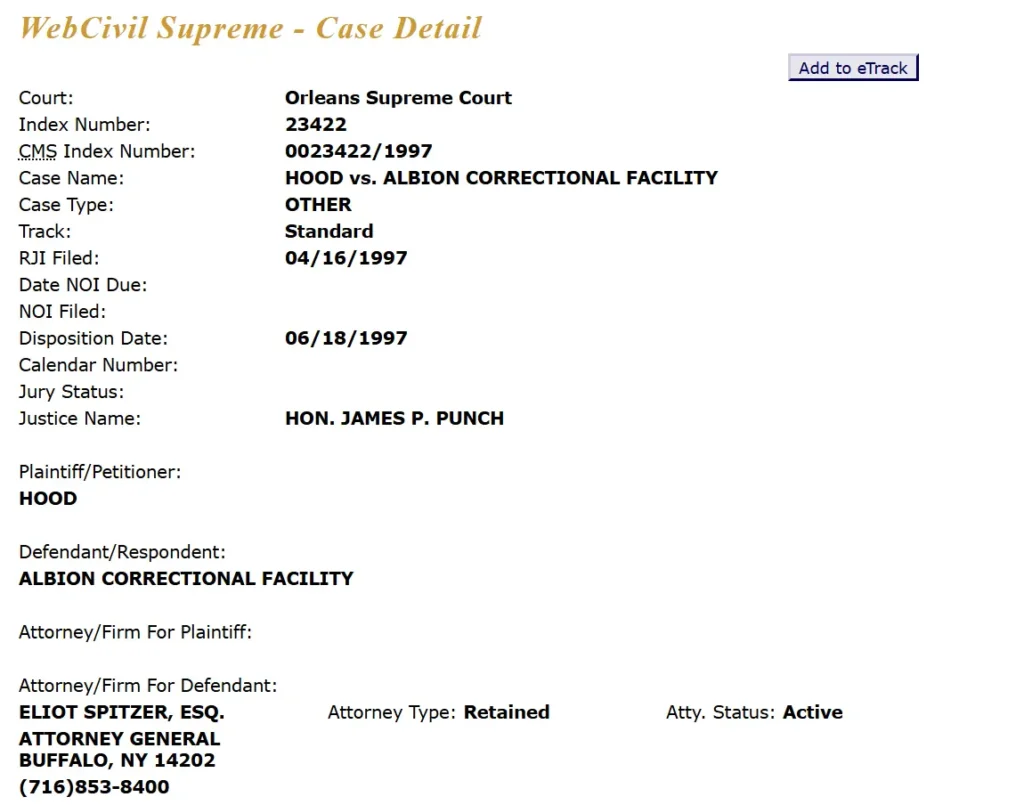WebCivil Supreme
The New York State WebCivil Supreme Court, with its broad jurisdiction and complex procedures, can often feel challenging to navigate.
For individuals without a legal background, understanding specialized terminology and intricate court processes can be a significant hurdle. Fortunately, an innovative online tool, WebCivil Supreme, is specifically designed to illuminate this legal landscape, offering a user-friendly platform that simplifies access to and comprehension of court records for all New Yorkers.
This comprehensive guide will explore the pivotal role of the New York State Civil Supreme Court, delve into the multifaceted functionalities of WebCivil Supreme, and provide a clear approach to effectively utilizing this powerful resource to navigate your legal journey with greater ease and understanding.
- Index Search
- Party Search
- Attorney/Firm Search
- Justice Search
- Court Calendars
- Attorney/Firm Calendars
- Document Search
There’s even a Mobile version of WebCivil Supreme, so you can check information on your phone or tablet.
Table of Contents
What is New York State Civil Supreme Court
The New York State Civil Supreme Court functions as a court of general jurisdiction, meaning it handles a vast array of civil cases. These range from personal injury claims, medical malpractice, and real estate disputes to complex commercial litigation, contract disagreements, and many other civil actions.
Its extensive jurisdiction spans all 62 counties of New York State, making it a sprawling and intricate system. This inherent complexity, coupled with specialized legal jargon and elaborate procedural rules, can create significant barriers to accessing and understanding relevant case information for those unfamiliar with the legal system.

Introducing WebCivil Supreme
WebCivil Supreme is an online platform meticulously designed to simplify the process of navigating the New York State Civil Supreme Court. It acts as a crucial digital bridge, connecting users with a wealth of court case information, all conveniently accessible from anywhere with an internet connection.
The platform prioritizes user-friendliness, presenting complex case information in a clear, concise, and easily digestible manner. This makes it readily understandable for both seasoned legal professionals and the general public, democratizing access to vital legal information and empowering New Yorkers to take a more active and informed role in their legal journeys.
Comprehensive Case Information at Your Fingertips
One of WebCivil Supreme’s primary strengths lies in the comprehensive nature of the case information it provides. For any Civil Supreme Court case across all 62 counties of New York State, users can access an extensive array of details.
This includes, but is not limited to:
- The names of all parties involved (plaintiffs and defendants).
- Their legal representation (attorneys and law firms).
- Scheduled court appearance dates.
- The specific types of legal actions being pursued.
- And, in many instances, even the decisions rendered by the court.
This rich trove of information is immensely beneficial not only for individuals directly involved in a court case but also for legal professionals conducting research, preparing for upcoming proceedings, or analyzing legal precedents.
By offering a comprehensive overview, WebCivil Supreme equips users with the knowledge and context needed to navigate the complex legal landscape effectively.
Real-Time Updates for Dynamic Legal Proceedings
The legal landscape is dynamic, with case statuses constantly evolving. WebCivil Supreme is built to keep pace, providing users with real-time updates on their cases.
For instance, when a judgment is signed by the court, the case status is promptly updated to “Disposed,” and a “JS/Date” (Judgment Signed/Date Signed) marking appears under the “Comments” column.
This real-time feature is particularly advantageous for individuals directly involved in a case, offering peace of mind and ensuring they are consistently informed of critical changes without needing to constantly contact the court or their attorney.
A Powerful Tool for New York Legal Professionals
While WebCivil Supreme is an invaluable resource for anyone involved in a New York State Civil Supreme Court case, its utility is particularly pronounced for legal professionals. Lawyers, paralegals, and legal researchers can significantly leverage the platform to:
- Access comprehensive case overviews.
- Streamline their research processes.
- Stay updated on the latest legal developments and case outcomes.
By providing a centralized and easily accessible repository of court case information, WebCivil Supreme saves legal professionals invaluable time and resources.
They are no longer required to sift through voluminous physical documents or make numerous trips to the courthouse, accessing everything they need from the convenience of their own workspace.
Benefits of WebCivil Supreme
WebCivil Supreme offers a multitude of benefits, solidifying its position as an indispensable tool for navigating the New York State Civil Supreme Court:
- Efficient Access: Seamless online access to court case information eliminates the necessity for physical courthouse visits, saving users valuable time and resources.
- User-Friendly Interface: The platform’s intuitive design and clear presentation of information make it accessible and easy to use for everyone, regardless of their technical expertise.
- Comprehensive Search Options: A variety of robust search options allow users to find cases by index number, party name, attorney/firm name, or justice name, making it effortless to locate specific information.
- Real-Time Updates: The platform is diligently updated, ensuring users have access to the most current and accurate case information available.
- Positive User Feedback: WebCivil Supreme has garnered widespread positive reviews, consistently commended for its ease of use, efficiency, and unparalleled convenience.
A Step-by-Step Guide to Utilizing WebCivil Supreme
WebCivil Supreme provides several functionalities to help users effectively find the case information they need:
Effective Case Searches
To maximize the effectiveness and efficiency of your case searches on WebCivil Supreme, consider implementing the following practical tips:
- Index Search: Find cases by their unique index number.
- Party Search: Locate cases by entering the name of any involved party (plaintiff or defendant).
- Attorney/Firm Search: Find cases by entering the name of the attorney or law firm representing a party.
- Justice Search: Find cases by entering the name of the justice presiding over the case.
- Use Accurate Information: Always ensure that the information you enter is precise to yield the most relevant results.
- Regularly Check Your Case Status: Your case status generally won’t appear online until it has been officially assigned to a judge. Check regularly for updates.
Navigating Court Calendars with Ease
WebCivil Supreme’s court calendars are an incredibly valuable tool for managing court appearances and staying informed about scheduled case events.
You can efficiently find calendar information by specifying the county, the assigned justice, and the court part. This detailed information can significantly help you plan your schedule and ensure you are thoroughly prepared for your court appearance.

Accessing Key Legal Documents
The Document Search feature allows you to access published decisions directly related to a specific case. You can locate these decisions by simply entering the index number and the county in which the case was filed.
This feature is particularly useful for in-depth legal research, understanding case precedents, and gaining insights into judicial reasoning.
Seamless Integration with eCourts
WebCivil Supreme is designed to seamlessly integrate with eCourts, the New York State court system’s overarching electronic filing system (NYSCEF).
This crucial integration allows for highly efficient case tracking and management, making it significantly easier for users to access and manage their case information entirely online.
Key Case Statuses
When utilizing WebCivil Supreme, you may frequently encounter two distinct terms that indicate the status of a case: “Disposed” and “Dismissed.” Understanding the precise meaning of these terms is vital for accurate interpretation.
- Disposed: This term signifies that the case has reached a resolution in some manner. This resolution could be achieved through a settlement agreement between the parties, a verdict rendered by a jury or judge, or various other forms of final resolution.
- Dismissed: This term indicates that the court has formally closed the case without issuing a final decision on the underlying merits of the case. A dismissal can occur for various reasons, such as a lack of proper jurisdiction, a failure by a party to diligently prosecute the case, or an out-of-court settlement that leads to the case being withdrawn.
Understanding these critical terms is crucial for accurately interpreting the information you find on WebCivil Supreme and comprehending the implications for your specific case.

Empowering Your Legal Journey in New York
WebCivil Supreme stands as a powerful and transformative tool that can significantly simplify the often-complex process of navigating the New York State Civil Supreme Court system. By providing easy access to comprehensive case information, delivering real-time updates, and offering a variety of intuitive search options, it empowers both legal professionals and the general public to take proactive control of their legal journeys.
Whether you are an individual directly involved in a court case, a lawyer meticulously preparing for a trial, or a researcher diligently studying legal trends, WebCivil Supreme can be an invaluable and indispensable resource for your New York legal needs. By fully understanding its functionalities and effectively utilizing its diverse features, you can navigate the complexities of the New York State Civil Supreme Court with enhanced confidence and remarkable ease.
Conclusion
WebCivil Supreme represents a transformative digital tool that effectively simplifies the often-daunting task of navigating the New York State Civil Supreme Court system. By providing easily accessible, comprehensive, and consistently up-to-date case information, it empowers individuals and legal professionals alike to remain thoroughly informed and actively engaged in their respective legal journeys.
Its intuitive interface, coupled with powerful search functionalities and seamless integration with the broader eCourts system, positions it as an indispensable resource for anyone involved in a New York State Civil Supreme Court case. Whether your objective is to seek information about a specific case, diligently track the progress of your own legal matter, or conduct in-depth legal research, WebCivil Supreme provides the essential tools and extensive resources you need to navigate the legal landscape with unparalleled confidence and impressive ease. By diligently understanding and effectively utilizing the comprehensive functionalities of WebCivil Supreme, you can unlock a wealth of critical information and gain a deeper, more profound understanding of the legal process in New York.
FAQ
What is WebCivil Supreme?
WebCivil Supreme is an online platform that provides convenient access to case information for the New York State Civil Supreme Court. It serves as a valuable resource for legal professionals, researchers, and individuals directly involved in court cases across all 62 counties of New York.
What kind of information can I find on WebCivil Supreme?
WebCivil Supreme offers comprehensive case information, including party names (plaintiffs and defendants), legal representation (attorneys and law firms), scheduled court dates, case types, and in many instances, copies of court decisions. You can also access detailed court calendars and attorney calendars.
How do I search for a case on WebCivil Supreme?
WebCivil Supreme provides several robust search options to help you locate cases. You can search by the unique case index number, by the name of any party involved, by the name of the attorney or law firm, or by the name of the presiding justice.
How often is the information on WebCivil Supreme updated?
WebCivil Supreme is regularly updated to ensure users have access to the most current and accurate case information available in the system.
What does it mean if a case is marked as “Disposed”?
“Disposed” signifies that the case has reached a resolution. This resolution can occur through various means, such as a settlement agreement, a verdict delivered by the court, or another form of final resolution.
What does it mean if a case is marked as “Dismissed”?
“Dismissed” indicates that the court has formally closed the case without issuing a final decision on its merits. This could be due to a variety of reasons, including a lack of proper jurisdiction, a failure by a party to prosecute the case diligently, or a settlement reached outside of court.
Can I check the status of my case on WebCivil Supreme?
Yes, you can check your case status by searching for it using either the Index Search or the Party Search. However, it’s important to remember that your case status may not appear online until it has been officially assigned to a judge.
How can I access documents related to a case?
You can use the Document Search feature to find published decisions related to a case by entering the case’s index number and the county in which it was filed.